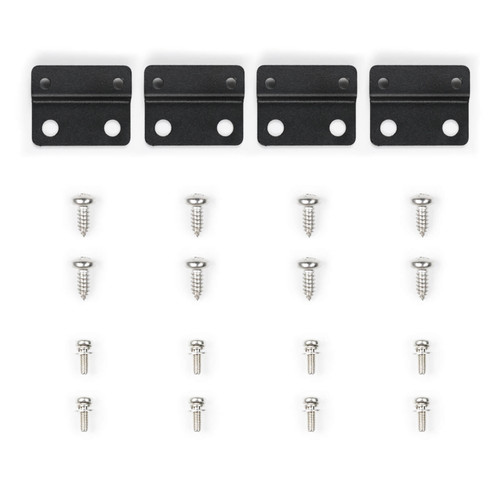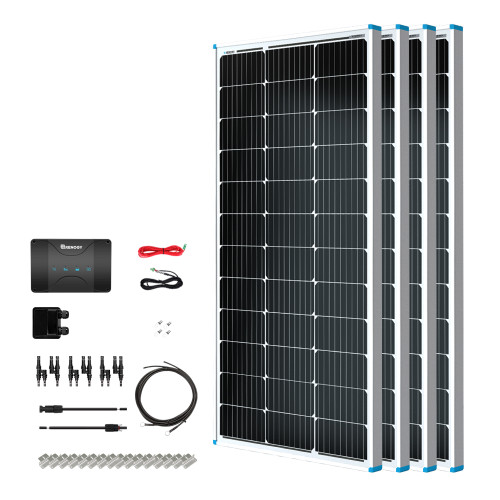400W Complete Kit with Two 100Ah Lithium Batteries
Go green with Renogy 400W 12 Volt Complete Solar Kit. This all-in-one package, just like other complete kits that include AGM batteries, provides all you need for your solar setup in tool sheds, hunting cabins, medium to large RVs, and many other off-grid sites.
Water Resistance
No more worries about rains or splashes. Splash-resistant junction box and waterproof solar connectors protect your solar panel all along adventures.
Wind & Storm Resistance
Low iron tempered glass and rugged aluminum frame combine to brave snow load up to 5400 Pa and high winds up to 2400 Pa in challenging weather.
Safer Battery Charging
While maximizing solar harvest, Renogy Rover 40A MPPT Solar Charge Controller actively monitors voltage & current to safeguard your batteries and system from hazards.
Saving is Earning
For the first time, the included activation switch allows you to easily turn your smart LiFePO4 battery on or off during installation or storage, enhancing security and reducing power loss to just 3% per year.
Step 1
Step 2
Step 3
Step 4
Package Includes
100W Monocrystalline Solar Panel
x 2
40A MPPT Solar Charge Controller w/Bluetooth Module
x 1
12V 100Ah Smart Lithium Battery w/ Bluetooth & Self-heating Function
x 2
2000W 12V Pure Sine Wave Inverter
x 1
4 Set of Solar Panel Mounting Z Bracket
x 4
Solar Y Branch Connectors MMF+FFM Pair
x 3
20FT 10AWG Solar Panel to Charge Controller Adaptor Kit
x 1
8FT 8AWG Battery to Charge Controller Tray Cables
x 1
16In 4AWG Copper Battery Interconnect Cable for 5/16 in Lugs
x 2
2FT 8AWG ANL Fuse Cable with Double Ring Terminals for 3/8 in Lugs
x 1
40A ANL Fuse Set w/ Fuse
x 1
30A Solar Connector Waterproof In-Line Fuse Holder w/ Fuse
x 1
Battery Inverter Cables for 3/8 in Lugs
x 1
BT-2 Bluetooth Module
x 1
RENOGY 100W MONOCRYSTALLINE SOLAR PANEL
Maximum Power
100W
Maximum System Voltage
600V DC (UL)
Open-Circuit Voltage (Voc)
24.3V
Optimum Operating Voltage (Vmp)
20.4V
Short-Circuit Current (Isc)
5.21A
Optimum Operating Current (Imp)
4.91A
Dimensions
41.8 x 20.9 x1.4 in
Weight
14.1lbs/6.4kg
ROVER LI 40A MPPT CHARGE CONTROLLER
Nominal System Voltage
12V/24V Auto Recognition
Rated Charge Current
40A
Max. PV Input Voltage
100 VDC
Max. PV Input Power
12V/520W, 24V/1040W
Max Battery Voltage
32V
Renogy 2000W 12V Pure Sine Wave Inverter
Continuous Output Power
2000W
Peak Power Rating
4000W
Output Voltage
115V
Dimensions
17.8 x 8.6 x 4 in
Weight
11.7 lbs
Deep Cycle AGM Battery 12 Volt 100Ah
Battery Type
AGM
Rated Capacity
100Ah (10 Hour Rate to 10.5V)
Nominal Voltage
12V
Cycle Use Voltage
14.4V~14.8V
Dimensions
13.1 x 6.9 x 8.6 in / 332 x 175 x 219 mm
Weight
63.9 lbs / 29 kg
100Ah Smart Lithium Iron Phosphate Battery w/ Bluetooth & Self-Heating Function
Battery Type
Lithium Iron Phosphate
Rated Capacity
100AH
Voltage Range
10V to 14.8V
Dimensions
10.6 x 7.6 x 8.1 in (268 x 193 x 205 mm)
Weight
26.9 lbs. (12.2 kg)
FAQ
1.What do I need to complete my off-grid solar power system?
A solar panel has to be connected to a charge controller to regulate current, and a battery to store the electrical power. You will need adapter kit cables to wire the solar panel(s) and charge controller, and tray cables connecting the charge controller to a deep-cycle battery. You will also need an inverter to convert DC power to AC power to power AC home appliances.
2. What does off-grid and on-grid mean?
On-grid simply means solar power equipment (array or solar panel) is connected to the electrical grid, while off-grid refers to systems that are not connected to the grid and therefore store the generated power for later use. Off-grid systems are not affected by grid blackouts.
3. Why is my solar panel under producing?
The output performance of solar panels is dependent on multiple factors. These include sunlight intensity, temperature, and weather conditions. Indirect sunlight, rising temperatures, cloudiness, and dust and dirt build-up can reduce the output of your solar panel.
4. How should I connect multiple solar panels for my system? Should I use a series or parallel configuration?
How you choose to connect multiple solar panels depends both on the size of your off-grid solar system and your power needs.
Connecting solar panels in a series increases the voltage of the system, leaving the system current output the same as a single panel. The total amount of voltage of a series connected array can be measured by multiplying the voltage output of a single panel by the number of panels. Or if you have panels of different voltages you add the voltage of each panel to get the total voltage of the array.
Connecting solar panels in parallel increases the current of the array and maintains the voltage output of a single panel. The total current of a solar array connected in parallel can be measured by multiplying the current of a single panel by the number of panels. Make sure the open circuit voltage of the connected panels does not exceed the maximum DC input voltage of the power station or controller.
5.How many solar panels do I need?
The best way to estimate how many solar panels you need is to understand and define the power load of a battery system. Power is measured in watts, and capacity in Watt-hours (multiplying power output in watts by the required runtime of power loads. Then, multiplied by a safety factor of 1.5-2). So, we advise you to size your battery bank first based on the minimum required capacity and decide how many panels or how much power input is needed accordingly.
6.Can I add more solar panels to the Rover 40A and expand my system power output?
Yes, you can add more solar panels in series/parallel to increase the power output. The Rover 40A solar charge controller has a maximum PV input current of 40A, maximum PV input voltage of 100VDC, and maximum input solar power of 520W at 12V or 1040W at 24V. You are limited by the maximum input voltage and current the charge controller can handle. Building a system operating at around 90% of the rated voltage and current is safer to ensure tolerance for any system overvoltage or overcurrent.
7.Will this solar kit power my AC home appliances?
In order to determine what size solar kit is appropriate, you must first define the total load to be expected of the solar power system. Most manufacturers will publish a specification sheet of the AC unit online and will include a nameplate sticker on the body of your AC home appliances. Both can be used to determine the actual power rating of the AC. BTU is a common measuring unit for energy in AC and water heater products, however we are intrested in the energy rate, or simply power.
Power will be listed in units of Watts, and can be used to determine the total load resulting from running the intended AC unit. Multiply the power rating recorded in watts by the total number of hours of operation intended, to obtain the total watt-hours. Divide the total watt-hours by the peak sun hours in the location of installation, and multiply by a safety factor of 1.5-2, to obtain the total number of watts your panels should produce to power the air conditioner load. The total power load can be divided by the power output of one panel to obtain the number of panels needed.
8.When do I need an inverter?
If you intend to use this solar power kit as a power supply for home appliances (e.g. coffee maker, TV, etc.), then you will need an inverter to convert the output voltage from a 12 VDC system to a 120V AC output socket. Renogy offers a variety of inverter products to suit your unique system and meet your power demand.
More questions about your off-grid power system? Learn more from Renogy Learning Center!
Resources Download
Manual
































































